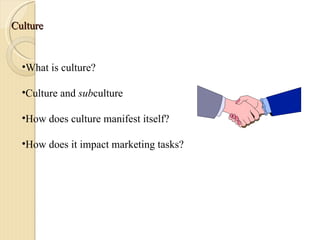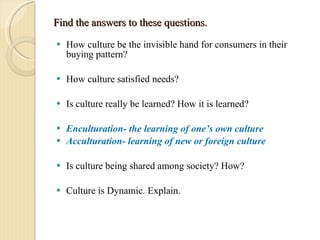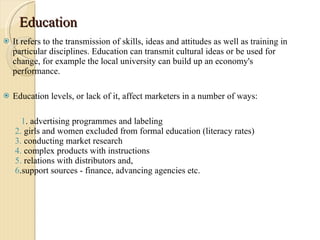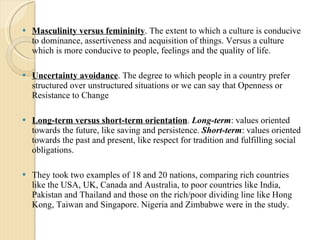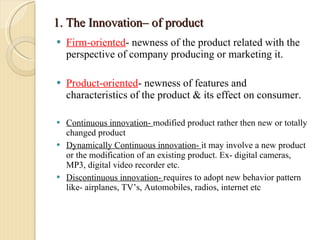Culture of Consumer Behavior
- 1. Culture What is culture? Culture and sub culture How does culture manifest itself? How does it impact marketing tasks?
- 2. Definition Culture : “That complex whole which includes knowledge, belief, art, morals, custom, and any other capabilities and habits acquired by man as a member of society.” Culture includes almost everything that influences an individual’s thought processes and behaviours
- 3. Impact of Culture Norms—ranges of appropriate behavior Consumption Patterns Sanctions— penalties for violating social norms Cultural Values
- 4. Classification of Cultural Values Three broad classifications are used: Other-oriented Environment-oriented Self-oriented
- 5. Other-Oriented Values Individual vs collective Romantic orientation (love) Adult vs child (child’s place) Masculine vs feminine (male role) Competition vs cooperation Youth vs age (wisdom of elders)
- 7. Environment-Oriented V alues Cleanliness (extent of) Performance vs status (performance or class) Tradition vs c hange (new behaviours?) Risk-taking vs s ecurity (risk encouraged?) Problem-solving vs f atalism (problem-solving or acceptance encouraged?) Nature (admired or overcome?)
- 9. Self-Oriented values Active vs p assive (physical activity) Material vs n on-material approach (acquisition?) Hard work vs l eisure (admire hard work?) Postponed vs immediate gratification (save/enjoy now) Sensual gratification vs abstinence (food, drink) Humour vs seriousness (is life serious?)
- 11. Find the answers to these questions. How culture be the invisible hand for consumers in their buying pattern? How culture satisfied needs? Is culture really be learned? How it is learned? Enculturation- the learning of one’s own culture Acculturation- learning of new or foreign culture Is culture being shared among society? How? Culture is Dynamic. Explain.
- 13. social interactions among people; nuclear family, extended family; reference groups language has two parts: the spoken and the silent language ideas and perceptions that a culture upholds in terms of beauty and good taste community’s set of beliefs that relate to a reality that cannot be verified empirically One of the major vehicles to channel from one generation to the next values shape people’s norms and standards technologies that are used to produce, distribute, and consume goods and services Material Life Value System Education Religion Aesthetics Language Social Interaction Components of culture
- 14. Material Culture It refers to tools, artifacts and technology. Before marketing in a foreign culture it is important to assess the material culture like transportation, power, packaging, communications and so on. It relates to the way in which a society organizes and views its economic activities. It includes the techniques and know-how used in the creation of goods and services, the manner in which the people of the society use their capabilities, and the resulting benefits. When one refers to an 'industrialized' or a 'developing' nation, one is really referring to a material culture. The material culture of a particular market will affect the nature and extent of demand for a product
- 15. The material culture of a country may also necessitate modifications to the product in terms of weights and measurements that have to be converted to those applicable in the importing country (ex-US uses measures such as miles, gallons and pounds, whereas most other parts of the world use the metric system - kilometers, liters and kilograms). Material culture can also have a significant effect on the proposed marketing and distribution strategies. like-highways and rail transport are the principal means of moving goods within the US, rivers and canals are used extensively in certain European countries. If the company is planning to develop a manufacturing operation in a foreign market, aspects such as the supply of raw materials, power, transportation and financing need to be investigated first.
- 16. Language It is central to the expression of culture. Within each cultural group, the use of words reflects the lifestyle, attitudes and many of the customs of that group. Language is not only a key to understanding the group, it is the principal way of communicating within it. A language usually defines the parameters of a particular culture. Thus if several languages are spoken within the borders of a country, that country is seen to have as many cultures. If promotional material needs to be prepared in a foreign language, it is important to ensure that none of the meaning is lost or distorted when the information is translated. Thus, translations should be undertaken within the country concerned or at least by a native of the country in question
- 17. Aesthetics Aesthetics refer to the ideas in a culture concerning beauty and good taste as expressed in the arts -music, art, drama and dancing and the particular appreciation of colour and form. Like African music is different in form to Western music. Aesthetic differences affect design, colours, packaging, brand names and media messages. It also embrace people's dress and appearance, i.e. their outward garments and accessories. Distinctive national attire, for instance, includes the Japanese kimono, Dutch clogs, and the Englishman's bowler hat.
- 18. Education It refers to the transmission of skills, ideas and attitudes as well as training in particular disciplines. Education can transmit cultural ideas or be used for change, for example the local university can build up an economy's performance. Education levels, or lack of it, affect marketers in a number of ways: 1 . advertising programmes and labeling 2. girls and women excluded from formal education (literacy rates) 3. conducting market research 4. complex products with instructions 5. relations with distributors and, 6 .support sources - finance, advancing agencies etc.
- 19. Religious beliefs A religious system refers to the spiritual side of a culture or its approach to the supernatural. Although very few religions influence business activities directly, the impact of religion on human value systems and decision-making is significant. Thus, religion exerts a considerable influence on people's actions and outlook on life, as well as on the products they buy. A society's religious belief system is often dependent on its stage of human or economic development. They tend to be superstitious about life in general while people in technologically advanced cultures seem to focus on scientific approaches of business only “ To disregard the significance of religious beliefs or superstitions evident in a potential export market could result in expensive mistakes.”
- 21. Indian consumers are culture-oriented in the sense that they conform to the cultural expectations of society. Core values of a society are adopted by a significant number of people; are enduring or followed by people for a long time; and enables marketers to understand the behaviour of consumers. The following are some of the core values of Indians:- Family orientation- Not only includes one’s own family but also extended family- siblings, parents, grandparents etc. In such type of family’s male is a wage earner – as the chief of the family. Value- based brands at low- price The brand at the lower end of the market in a number of product categories like tea, soap, toothpaste, and shampoo typically cater to these kinds of consumers.
- 22. This type of consumers also mixes the brands and products from unorganized sector to balance his/ her expenditure on such consumption needs. Unilever India Limited and Colgate has a number of price points in almost all its product line. Savings Orientation Saving a good portion of money and spend the little for basic needs only (earlier) Now, people are buying , above their basic needs. Like bicycles, bikes, cars, TV’s, computers etc (installment basis for convenient living) Investing money in gold is a key factor. People use to buy jeweler from their family jewelers rather from brands like Tanishq (2% market capturing)
- 23. Festivities A number of companies step up their advertisement campaigns during festive months. A number of consumers also postpone their purchases, specially durables in hope of getting various types of deals. Even a niche jewelry brands like Tanishq came out with rakhi’s in gold on raksha bandhan. Gold coins with images of god and goddess for the festival like dhanteras (sign- prosperity, and money).
- 24. Shopping as a Ritual Buying commodities and vegetables from routine shops or near by shops and hawkers even if the concept of BIG BAZAAR, SHOPER’S STOP etc spreaded out everywhere (urban areas) BIG BAZAAR- promise to give ambience, service, and variety. Bargaining, especially in the case of commodities and vegetables, is an unwritten rule in the transaction.
- 25. Food Habits Changing cultural trends in Indian Urban Market Achievement Orientation- membership prestigious club, holidaying in a foreign resort, possessing a middle- end car (Opel or Honda) Work Ethic- convenience products (one-stop shop, fast foods chains like Mc Donald's etc ) Material Success- Young highly qualified professional (25-30). The education, aspirations, and intelligence of these consumers have resulted in their acquiring substantial wealth. The wealth is spent on essential products and services like- health, entertainment, and convenience. There is a great demand for quality- oriented, branded services like laundry services, in- home delivery of food,, baby- sitters, pet-care people, and in small way, online marketing of essentials. Use of hi-tech products
- 26. Hofstede’s Contribution- Hofstede, Franke and Bond. “There theory is based on competitive theory of Michael Porter” Competitive Advantage (given by Michael Porter ) A competitive advantage is an advantage over competitors gained by offering consumers greater value, either by means of lower prices or by providing greater benefits and service that justifies higher prices.
- 27. Hofstede's contribution ‘ Culture’ The differences in Cultural values rather than in material and structural conditions (the private and state control) are ultimate determinants of human organization and behaviour, and thus of economic growth. THE FIVE CULTURAL DIMENSIONS OF HOFSTEDE The cultural dimensions model of Hofstede is a framework that describes five sorts (dimensions) of differences / value perspectives between national cultures: Power distance . The degree of inequality among people which the population of a country considers as normal. Individualism versus collectivism . The extent to which people feel they are supposed to take care for, or to be cared for by themselves, their families or organizations they belong to.
- 28. Masculinity versus femininity . The extent to which a culture is conducive to dominance, assertiveness and acquisition of things. Versus a culture which is more conducive to people, feelings and the quality of life. Uncertainty avoidance . The degree to which people in a country prefer structured over unstructured situations or we can say that Openness or Resistance to Change Long-term versus short-term orientation . Long-term : values oriented towards the future, like saving and persistence. Short-term : values oriented towards the past and present, like respect for tradition and fulfilling social obligations. They took two examples of 18 and 20 nations, comparing rich countries like the USA, UK, Canada and Australia, to poor countries like India, Pakistan and Thailand and those on the rich/poor dividing line like Hong Kong, Taiwan and Singapore. Nigeria and Zimbabwe were in the study.
- 29. High Individualism : US, Australia, Great Britain, Canada Low Individualism: Japan, Venezuela, Thailand, Japan, Mexico, China Feminine: Netherlands, France, Sweden Masculine: Japan, Mexico, Britain, Germany High : France, Japan, Mexico Low: India, Hong Kong, US, Great Britain Long Term: Hong Kong, Japan Short Term: Great Britain, US, Germany High : Korea, Japan, Mexico Low: India, Australia, US, Germany Individualism vs collectivism Masculinity Vs Femininity Uncertainty avoidance Long term orientation Power Distance Hofstede’s Cultural Factors Hofstede’s Cultural Factors
- 30. Adaptation of culture and Subculture with its type.
- 31. Subcultures Subgroups of people who don’t think/ behave alike. They share most of society’s norms, values, beliefs but they change some of society’s ideas to reflect more closely to their own needs. Important features of subculture: Provide a sense of belonging and identity. develop unique features rules of behavior are set up for dealing with the outside world. supports group members in their daily activity even if they are ridiculed by other groups in society, subculture members know that upon returning on their own, they will receive social support and approval Special signals- they are the same with the way they use language, dress, handshakes. They uses special signals to notice/ identify each other without being notice by an outsiders
- 32. Types of Subculture Nationality Subculture – Ex: Indians born in US and Indians born in India. US- Indians are influenced by Indian food, tradition, custom, beliefs etc. Religious Subculture- purchasing is done according to the religious identity or influenced by religious identity. Geographic and regional subculture- Consumption and eating habits depends on geographic conditions and region like Energy drinks are more prefer by San Francisco rather then Philadelphia, Ground Coffee is more liked by Boston people rather then Los Angeles one. Racial Subculture- Differences in lifestyle, consumer spending patterns etc. Age Subculture Gender Subculture- Masculine/ Feminine Market with their respective products
- 33. Cross Cultural Consumer behavior
- 34. What is Cross- Cultural Marketing? Cross-cultural marketing is defined as “the effort to determine to what extent the consumers of two or more nations are similar or different. This will facilitate marketers to understand the psychological, social and cultural aspects of foreign consumers they wish to target, so as to design effective marketing strategies for each of the specific national markets involved.” The firm’s objectives could be To determine how consumers in two or more societies are Similar / different and devise suitable, appropriate strategies Devise individualized marketing strategy if cultural beliefs, values and customs of a specific country are different
- 35. Variables Influencing Cross-Cultural Marketing Strategies
- 36. Cross-Cultural Variations: Factors influencing N on-Verbal communications and also become problems for the MARKETERS Time Space Friendship - Two or more nations with each other Agreements Symbols Etiquette (basic manners) National Language Country-of-Origin Issues Ethnocentricity Animosity Bi-national products Matchup Hypothesis
- 37. Time Perspective Monochronic One thing at a time Concentrate on one job Deadlines matter Commitment to task Adhesion to plans Promptness is valued Short-term relationships Australian and many other western culture Polychronic Many things at once Highly distractible Deadlines are secondary Commitment to people Changing plans is easy Promptness depends Long-term preferred Chinese, Koreans, Indians and Latin Americans
- 38. Symbols 7 is unlucky in Ghana, Kenya, lucky in India and in Czech Republic. 4 is unlucky in Japan, China. 8, 3, 2 sound good in Hong Kong. So, Symbols should be like that only which are not shown any negative signs for the buyers. Numbers, words, sentences all are come under such category
- 40. Ethnocentricity It is a common tendency for people to: Interpret others from the perspective of their own group. Reject those who are culturally dissimilar. Bi-national Products The current trend is manufacturing product components in one country and assembling in another, or designing in one and manufacturing in another. Firms should consider the effects of multiple national origins on product quality evaluations.
- 41. Matchup Hypothesis Consumers have preferences for goods that match their taste of the country of origin. Animosity Some people may prefer not to buy products from a certain country. Chinese consumers have been found to hold animosity towards Japanese products in general. Older Mexican consumers are less likely to buy U.S. products than younger Mexicans
- 42. Problems in Cross Cultural marketing Problems related to product selection : The marketer going for cross cultural marketing has to select the customers / market not on the basis of the superficial similarities of age or income, but by using the real motivating factors that prompt them to accept or reject products. Problems related to promotion/marketing communication : e.g. Ariel in the middle east and also Pepsi promotions according to the area and location. Problems related to pricing : the marketer has to adjust his pricing policies according to the local economic conditions and customs. Problems related to selection of distribution channels
- 43. Developing a Cross-Cultural Marketing Strategy (7 Questions) Is it a homogenous culture? What needs will the product fill? Can enough afford the product? What values are relevant to this product? What are the distribution, political and legal structures? How can the firm communicate about the product? What are the ethical implications?
- 44. CROSS-CULTURAL CONSUMER ANALYSIS..
- 45. Cross-Cultural Consumer Analysis To determine whether and how to enter in a foreign market, we need to conduct some form of cross-cultural consumer analysis. Cross-cultural consumer analysis can be defined as the effort to determine to what extent the consumers of two or more nations are similar or different. Such analysis can provide marketers with an understanding of the psychological, social, and cultural characteristics of the foreign consumers they wish to target, so that they can design effective marketing strategies for the specific national markets involved.
- 46. Basic research issues in cross-cultural analysis Differences in language and meaning, e.g. restroom Difference in market segmentation opportunities, e.g. age while buying the first car Difference in consumption patters, Difference in the perceived benefits of products and services, e.g. yogurt Differences in the criteria for evaluating products and services, e.g. credit cards Difference in economic and social conditions and family structure, e.g. family soap Differences in marketing research and conditions, e.g. direct-mail lists Differences in marketing research possibilities, e.g. telephone surveys
- 47. 1. Similarities and differences among people A major objective of cross-cultural consumer analysis is to determine how consumers in two or more societies are similar and how they are different. According to some personality traits or behavioral aspects of the consumer we can analyze the things. Fight for one’s beliefs/positions Individualistic Clear-cut Specific Display emotions in public Result oriented Make a short story long Verbal communication important Interested in what is spoken 2.The Growing global middle class 3.Acculturation is a needed marketing view point
- 48. DIFFUSION & ADOPTION OF INNOVATION
- 49. Diffusion & Adoption of innovations Diffusion of innovation is based on acceptance of new product by consumers. Researchers focused on the understanding of 2 closely related aspects- (a) Diffusion process (b) Adoption process Diffusion is a broader term, is a macro process concerned with the spread of a new produc t (an innovation) from its sources to the consuming public. Adoption is a micro process that focuses on the stages through which an individual consumer passes when deciding to accept or reject a new product. A ‘NEW’ Product means:- A touch of reality ; specifically in India Value, Convenience, and cultural association – Vatika hair oil(Lime & coconut), Good Night coil are the example related with the cultural practice of India
- 50. New Categories & the Diffusion of innovations New category of product - take the Example of Contact lenses have been in India from last 4 decades but not so popular. WHY? The following aspects related closely to the diffusion issues associated with the product category: What is the target segment & what is the benefit? How will the consumer be satisfied with the product? Are we able to spread the proper usage of the product?
- 51. There are some aspects related to the product that the marketer needs to look at in terms of product purchase & brand loyalty Knowledge Aspects : Is there a lack of understanding among the prospective consumers Persuasion Aspect : What is the Word of Mouth from users of the product? Is there bad WOM that a marketer needs to address? How this can be done? What is the most appropriate medium for achieving it? Decision Aspect : on what basis consumer take a decision to buy a product. Implementation of the decision : What kind of reassurance needs to be provided by the brand and the retailers to ensure that the consumer implements his/ her decision to try out the product? Should there be trail offers in addition to the reassurances provided? Confirmation : What should be the brand’s strategy to retain the consumer and ensure that he/she not leave the brand/ category?
- 53. Diffusion Process Diffusion is a process by which the acceptance of an innovation (new product, new service, new idea, or new practice) is spread by communication(mass media, sales people) to the members of a social system over a period of time. Definition includes- (a) The innovation, (b) the channels of communication (c) the social system, (d) time
- 54. 1. The Innovation– of product Firm-oriented - newness of the product related with the perspective of company producing or marketing it. Product-oriented - newness of features and characteristics of the product & its effect on consumer. Continuous innovation- modified product rather then new or totally changed product Dynamically Continuous innovation- it may involve a new product or the modification of an existing product. Ex- digital cameras, MP3, digital video recorder etc. Discontinuous innovation- requires to adopt new behavior pattern like- airplanes, TV’s, Automobiles, radios, internet etc
- 55. Market-oriented -newness of the product in terms of how much exposure is in the market among the consumer about the new product. Consumer-oriented- value, safety, suitability, usage, brand image.
- 56. How Consumer accept the new product? Relative advantage- the degree to which potential customers perceive a new product as superior to existing substitute. Ex- MP3 player over traditional CD player Compatibility- the degree to which new product is consistent with their present needs, values, and practices is a measure of its compatibility. Ex- Gillette MACH3 Turbo over disposable razors. Digital alarm clocks over analog alarm clock. Trailability- the degree to which a new product tried on a limited basis. The greater the opportunity to try a new product, the easier it is for consumers to evaluate it & ultimately adopt it. Ex- Free samples of creams, make-up kits Free trail of software like antivirus
- 57. Observability or Communicability- it’s a process with which a product’s benefits or attributes can be observed, imagined, or described to potential consumers ex- clothing like jean, sneakers, capries etc Complexity- the degree to which a new product is difficult to understand or use, affects product acceptance. The easier it is to understand &use a product, the more likely it is to be accepted. ex- electronic items
- 58. 2. The social system A social system is physical, social & cultural environment to which an individual belong & function accordingly. Ex- for new drug the social system consist of all physicians within a specific medical specialty. Like hybrid-seed- social systems would be all farmers When the social system is modern in thinking, the acceptance of innovations is likely to be high . Characteristics of Modern Social System are :- A positive attitude towards change An advance technology & skilled labor force A general respect for education & science An outreach perspective, in which members of the system frequently interact with the outsiders, thus facilitating the entrance of new ideas into social system
- 59. 3. The channel of communication 4. Time :- it is backbone of diffusion process. It includes three aspect to be search out The amount of purchase time- Purchase time refers to the amount of time that elapses between consumer’s initial awareness of a new product or services & the point at which they purchase or reject it. The identification of adopter categories- 5 categories are come under this- Innovators - Earliest Consumers specially for Hi-Tech Product and can pay any amount for the new product. They are the waiting buyers for the new product (act as an opinion leader for hi-tech products) Early Adopters- who buy the product within the short period of time following its introduction but not as early as innovators. They are those buyers who buy the product just to become superior in their social circle or neighborhood.
- 60. Early Majority- are those members who do not purchase the product when it was first introduce, they perceived purchasing as risky because it was new. But after small number of consumer purchased the product, these consumers conclude that purchasing the product is wise Late Majority- They are the late entrants or say late pickers of an innovation. They are the second half of the early majority group. They take relatively long time to evaluate the product & its benefits. “ Together the Early & Late Majority adopter categories constitute the large & maturing market for any innovation .”
- 61. Laggards - are the last group of consumers to purchase the innovation. When they are going to buy or thinking to buy the product at that time the innovators & early adopters are already probably switching to the more advanced innovations in this particular product . Laggards are the High-Risk perceivers & last ones to recognize the value of innovation. “ There are some consumers who are not categorize in the list of adopters & the are called non-adopters or non-purchasers”
- 62. Rate of Adoption It is concerned with how long the product is to be adopted by the members of a social system, that is how quickly it takes a new product to be accepted by those who will ultimately adopt it. Rate of Adoption for new products is getting faster or shorter = means the time lag is faster or shorter Ex- black-white TV take 12yrs time in Japan or India to reach to a same level of acceptance & then adoption as in US & for color TV the time is of 5yrs to reach in Japan and other counties & may be more several yrs in Europe or other countries
- 63. For increasing the demand or supply of the product What will be our strategy? Either we use Penetration Policy of pricing- set relatively low prices of the product or, Or use Skimming policy of pricing- set higher price first target the cream customers & then lower the price to target the lower base of the market.
- 64. ADOPTION PROCESS
- 65. Stages in Adoption Process Awareness : customer is exposed to the product Interest: interest and information seeking Evaluation: assessment of the advantages and disadvantages of the new product Trial: customer tries the product in low-risk situation; may be a sample or test drive Adoption: customer decides to buy the product Confirmation: customer decides to stay with the product
- 66. Finding out the % of adopter category Researchers have identified five categories of individual adopters for new products: Innovators — 3% of the market. Early adopters — 13% of the market. Early majority — 34% of the market. Late majority — 34% of the market. Laggards — 16% of the market Different products are having different % of 5 categories of adopters.
